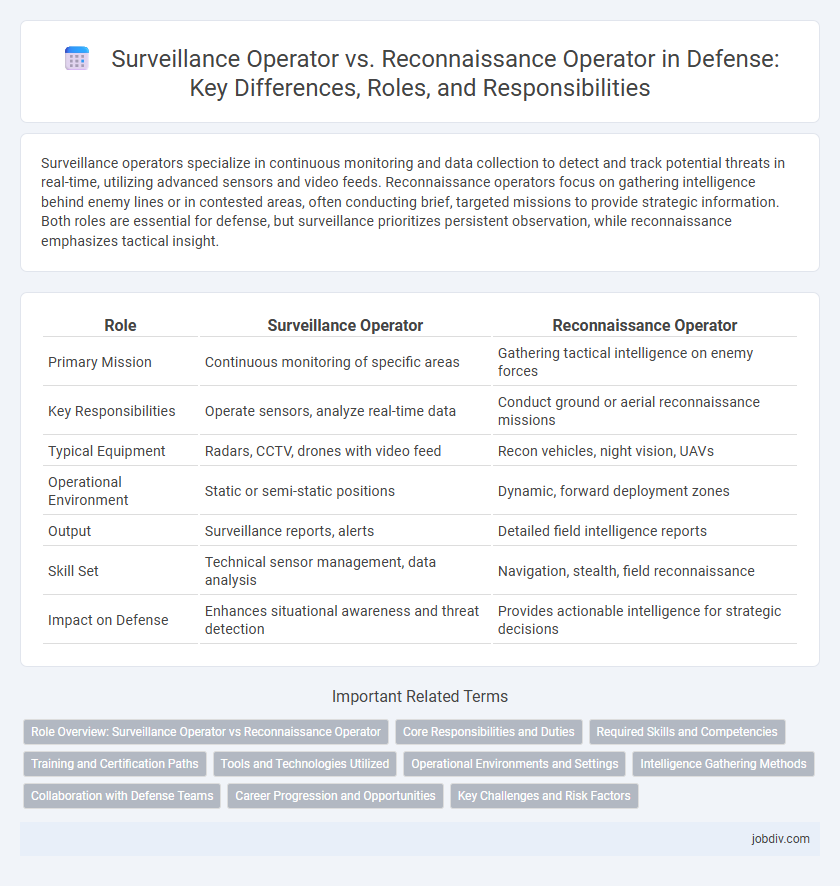Surveillance operators specialize in continuous monitoring and data collection to detect and track potential threats in real-time, utilizing advanced sensors and video feeds. Reconnaissance operators focus on gathering intelligence behind enemy lines or in contested areas, often conducting brief, targeted missions to provide strategic information. Both roles are essential for defense, but surveillance prioritizes persistent observation, while reconnaissance emphasizes tactical insight.
Table of Comparison
| Role | Surveillance Operator | Reconnaissance Operator |
|---|---|---|
| Primary Mission | Continuous monitoring of specific areas | Gathering tactical intelligence on enemy forces |
| Key Responsibilities | Operate sensors, analyze real-time data | Conduct ground or aerial reconnaissance missions |
| Typical Equipment | Radars, CCTV, drones with video feed | Recon vehicles, night vision, UAVs |
| Operational Environment | Static or semi-static positions | Dynamic, forward deployment zones |
| Output | Surveillance reports, alerts | Detailed field intelligence reports |
| Skill Set | Technical sensor management, data analysis | Navigation, stealth, field reconnaissance |
| Impact on Defense | Enhances situational awareness and threat detection | Provides actionable intelligence for strategic decisions |
Role Overview: Surveillance Operator vs Reconnaissance Operator
Surveillance Operators specialize in continuous monitoring and data collection through electronic systems and sensors to detect and track enemy movements in real time. Reconnaissance Operators conduct targeted missions to gather tactical intelligence via direct observation, often in hostile environments, enabling strategic decision-making on the battlefield. Both roles are critical for situational awareness but differ in operational scope, with surveillance emphasizing persistent observation and reconnaissance focusing on active, mission-specific intelligence gathering.
Core Responsibilities and Duties
Surveillance Operators specialize in monitoring and collecting real-time data through electronic systems such as radar, sensors, and cameras to detect and track potential threats or targets. Reconnaissance Operators focus on gathering detailed intelligence through physical or remote observation, often involving ground patrols or unmanned reconnaissance vehicles to assess enemy positions and terrain. Both roles are critical for situational awareness but differ in execution; surveillance emphasizes continuous information collection and threat detection, while reconnaissance prioritizes detailed, tactical insights for operational planning.
Required Skills and Competencies
Surveillance Operators require expertise in monitoring, data analysis, and real-time threat detection using advanced electronic systems and sensors. Reconnaissance Operators prioritize skills in field navigation, covert movement, and intelligence gathering to obtain actionable information from hostile or contested environments. Both roles demand high situational awareness, proficiency in communication technologies, and the ability to operate under stress in dynamic defense scenarios.
Training and Certification Paths
Surveillance Operators undergo rigorous training in sensor systems, target identification, and threat analysis, often requiring certification in advanced imaging technologies and remote sensing. Reconnaissance Operators focus on tactical field training, navigation, and intelligence gathering, typically obtaining qualifications in covert operations and battlefield communication. Both roles demand continuous skill updates through simulated exercises and joint training programs to maintain operational effectiveness.
Tools and Technologies Utilized
Surveillance operators utilize advanced tools such as radar systems, closed-circuit cameras, and motion sensors for continuous monitoring and data collection in real-time. Reconnaissance operators rely on technologies like unmanned aerial vehicles (UAVs), satellite imagery, and signal intelligence (SIGINT) equipment to gather tactical information during missions. Both roles integrate geographic information systems (GIS) for enhanced situational awareness but differ in the immediacy and scope of their technological applications.
Operational Environments and Settings
Surveillance operators primarily conduct continuous monitoring in fixed or semi-fixed environments such as border checkpoints, military bases, and urban conflict zones, utilizing stationary sensors and remote cameras to detect threats. Reconnaissance operators operate in dynamic and often hostile environments like forward combat areas, behind enemy lines, or rugged terrain, gathering critical intelligence through direct observation, stealth, and advanced reconnaissance technologies. Both roles support decision-making but differ in operational tempo and mobility, with surveillance emphasizing persistent observation and reconnaissance focusing on targeted intelligence collection.
Intelligence Gathering Methods
Surveillance operators employ persistent monitoring techniques using ground-based sensors, drones, and electronic intercepts to collect real-time data on enemy movements and communications. Reconnaissance operators execute tactical missions involving covert patrols, human intelligence (HUMINT) collection, and close-range observation to obtain detailed information on terrain, enemy strength, and positions. Both roles leverage advanced technologies such as signal intelligence (SIGINT) and imagery intelligence (IMINT) to enhance battlefield awareness and support strategic decision-making.
Collaboration with Defense Teams
Surveillance Operators and Reconnaissance Operators collaborate closely with defense teams to enhance situational awareness and operational effectiveness. Surveillance Operators monitor and interpret real-time data from sensor systems, providing critical intelligence that supports threat detection and asset protection. Reconnaissance Operators conduct forward-deployed missions to gather actionable information, enabling defense teams to make strategic decisions and execute targeted responses.
Career Progression and Opportunities
Surveillance Operators often begin their careers monitoring and analyzing real-time data from various sensors, advancing to roles such as intelligence analysts or mission planners with expertise in electronic surveillance systems. Reconnaissance Operators typically gain field experience in tactical information gathering, progressing to positions like special operations leadership or reconnaissance team commanders specializing in strategic field operations. Both career paths offer opportunities for cross-training, advanced technical certifications, and transition into defense intelligence or cybersecurity roles that leverage their specialized skill sets.
Key Challenges and Risk Factors
Surveillance Operators face key challenges such as maintaining continuous data monitoring and managing large volumes of real-time information, which increases the risk of operator fatigue and sensor blind spots. Reconnaissance Operators encounter risks related to covert mission execution, including exposure to hostile environments and the need for rapid decision-making under uncertain conditions. Both roles demand high situational awareness and advanced technological proficiency to mitigate these operational risks effectively.
Surveillance Operator vs Reconnaissance Operator Infographic

 jobdiv.com
jobdiv.com